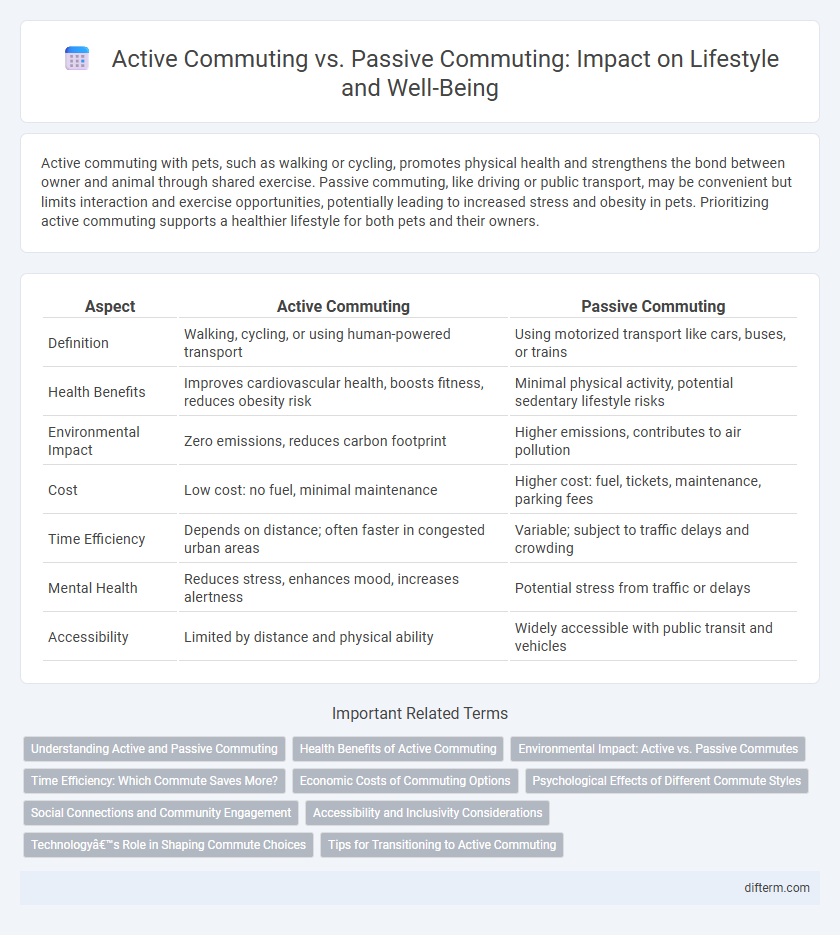Active commuting with pets, such as walking or cycling, promotes physical health and strengthens the bond between owner and animal through shared exercise. Passive commuting, like driving or public transport, may be convenient but limits interaction and exercise opportunities, potentially leading to increased stress and obesity in pets. Prioritizing active commuting supports a healthier lifestyle for both pets and their owners.
Table of Comparison
| Aspect | Active Commuting | Passive Commuting |
|---|---|---|
| Definition | Walking, cycling, or using human-powered transport | Using motorized transport like cars, buses, or trains |
| Health Benefits | Improves cardiovascular health, boosts fitness, reduces obesity risk | Minimal physical activity, potential sedentary lifestyle risks |
| Environmental Impact | Zero emissions, reduces carbon footprint | Higher emissions, contributes to air pollution |
| Cost | Low cost: no fuel, minimal maintenance | Higher cost: fuel, tickets, maintenance, parking fees |
| Time Efficiency | Depends on distance; often faster in congested urban areas | Variable; subject to traffic delays and crowding |
| Mental Health | Reduces stress, enhances mood, increases alertness | Potential stress from traffic or delays |
| Accessibility | Limited by distance and physical ability | Widely accessible with public transit and vehicles |
Understanding Active and Passive Commuting
Active commuting, such as walking or cycling, promotes physical health by integrating exercise into daily routines and reducing the risk of lifestyle-related diseases. Passive commuting involves using motorized transportation like cars or buses, which contributes to sedentary behavior and increased environmental pollution. Understanding the benefits of active commuting can motivate individuals to adopt healthier, more sustainable travel habits that improve both personal well-being and community air quality.
Health Benefits of Active Commuting
Active commuting, such as walking or cycling, significantly boosts cardiovascular health by increasing heart rate and improving circulation. Regular physical activity during commutes reduces the risk of chronic diseases like obesity, type 2 diabetes, and hypertension. Mental well-being also improves through stress reduction and enhanced mood, contributing to overall health benefits linked to active commuting.
Environmental Impact: Active vs. Passive Commutes
Active commuting, such as walking or cycling, significantly reduces carbon emissions and air pollution compared to passive commuting methods like driving or taking a bus. Studies show that replacing car commutes with active transportation can lower an individual's carbon footprint by up to 50%. Urban areas benefit from increased air quality and decreased greenhouse gas emissions when residents adopt active commuting habits.
Time Efficiency: Which Commute Saves More?
Active commuting methods like biking and walking can save significant time during peak traffic hours by bypassing congestion and avoiding delays common in passive commuting such as driving or public transit. Studies show that active commuters often experience shorter total commute times within urban areas due to consistent speed and direct routes. Time efficiency gains vary based on city infrastructure but generally favor active commuting for distances under five miles.
Economic Costs of Commuting Options
Active commuting, such as walking or cycling, significantly reduces economic costs by eliminating fuel expenses, parking fees, and vehicle maintenance compared to passive commuting modes like driving or public transit. Studies show that households using active commuting can save an average of $2,000 to $5,000 annually, considering reduced healthcare costs due to increased physical activity. Choosing active commuting enhances financial savings while promoting health benefits, making it a cost-effective lifestyle choice.
Psychological Effects of Different Commute Styles
Active commuting, such as walking or biking, significantly reduces stress levels by promoting physical exercise and exposure to natural environments, which boost endorphin production and improve mood regulation. In contrast, passive commuting methods like driving or public transit often increase anxiety and feelings of helplessness due to traffic congestion and unpredictability. Studies indicate that individuals engaged in active commuting report higher overall psychological well-being and lower instances of depression compared to those who rely on passive commuting options.
Social Connections and Community Engagement
Active commuting, such as walking or cycling, fosters stronger social connections by increasing opportunities for casual interactions with neighbors and local businesses, enhancing community engagement. Regular physical presence in public spaces encourages a sense of belonging and collective identity, which can lead to greater participation in community events and local initiatives. In contrast, passive commuting modes like driving often isolate individuals, reducing spontaneous social encounters and limiting the development of vibrant, interconnected communities.
Accessibility and Inclusivity Considerations
Active commuting options such as walking and cycling improve accessibility by reducing dependency on vehicles and public transit schedules, making travel more flexible for individuals with varying mobility levels. Inclusive infrastructure design, including tactile paving, ramps, and well-lit pathways, ensures that people with disabilities or limited physical abilities can participate in active commuting safely. In contrast, passive commuting often requires access to private cars or public transit systems that may lack comprehensive accommodations, limiting accessibility for vulnerable populations.
Technology’s Role in Shaping Commute Choices
Smartphone apps and GPS technology have revolutionized active commuting by providing real-time navigation, route optimization, and safety alerts, encouraging more people to walk or bike. Wearable fitness trackers motivate commuters to integrate physical activity into their daily routines, turning passive commutes into health-enhancing opportunities. Public transit apps and ride-sharing platforms also influence commute choices by offering convenient alternatives that blend active and passive transportation modes.
Tips for Transitioning to Active Commuting
Incorporate gradual changes such as starting with walking or biking short distances to build stamina when transitioning to active commuting. Invest in proper gear like comfortable shoes, weather-appropriate clothing, and a reliable bike to enhance safety and comfort. Plan routes that prioritize bike lanes or pedestrian paths, and establish a consistent schedule to maintain motivation and develop a sustainable active commuting habit.
active commuting vs passive commuting Infographic

 difterm.com
difterm.com